Genre: Run-‘n-Gun Developer: Sega Ent. Publisher: Sega Ent. Players: 1-2 Released: 1986
My battle to complete The Ninja goes back to December, 1986. My father took me to buy an NES on Christmas Eve – that’s right, the very day before Christmas – and we went to almost a dozen stores to find one. All were sold out, so he gave me the options of an Atari 2600 Jr. with 10 games or a Master System with one. I was tempted by the 2600 because of the instant library I’d get and all the fond memories I had with the machine, but the Master System won out thanks to its great visuals and arcade titles. Of course, the console came with Hang-On/Safari Hunt, and my brother chipped in and bought F-16 Fighting Falcon. For my additional game, I chose The Ninja.
It was on that day that my seemingly eternal war with this great little run-‘n-gun began. See, I could easily get through the game, honing my ninja skills to almost championship levels. The problem was that I couldn’t get the real ending, since five hidden scrolls are required to access the last level and rescue the princess. I could only find three, and in those pre-Internet days, only magazine were available for cheats and tips. Sadly, none that I ever read revealed the locations of the final two scrolls, and at the time, I wasn’t privy to fact that there were Sega cheat sheets that could be obtained through the 1-800-USA-SEGA hotline. Thus, the game remained unfinished for me for practically three decades. I spent that time searching… hunting for the remaining scrolls, as though finding them would open the door to ultimate power or something. In reality, I’d get a lame ending screen and the satisfaction of conquering another Sega title, but I can assure you that the stakes felt much larger for me!
It was also during that period that I read up on the origins of the The Ninja and how it was an adapted version of the 1985 arcade title Sega Ninja. The Master System port received a change of main character (originally a girl named Princess Kurumi), as well as a graphical overhaul and some level redesigns. The most notable change was the addition of the aforementioned scrolls, much to my chagrin. The game was released as part of Sega’s 8-bit “Martial Arts Trio,” which included Black Belt and Kung Fu Kid.
Essentially, The Ninja plays the same as its arcade sibling. It’s a mostly vertical-scrolling run-‘n-gun that has the brave Kazamaru battling evil ninjas en route to the Ohkami Castle. There, the evil Gyokuro must be defeated and the princess rescued. Typical arcade fare of the time, to be sure, but story is never needed when battling ninjas. All one must do is advance through to the end of the stage and defeat the boss, using an endless supply of darts along the way. Kazamaru also has the ability to briefly turn invisible when both buttons 1 and 2 are pressed together, and this is quite useful for dodging enemy crossfire or to avoid being trapped in a corner.
Each of the game’s 13 stages is filled with varied foes. Ninjas of all types have answered Gyokuro’s call to terrorize the nation, and they brandish shuriken stars, sickles, and katanas, disguise themselves as rocks, hide in the ground, transform into wolves, and breathe fire. Thankfully, Kazamaru isn’t without resources, and red scrolls can be obtained to make his darts tear through several enemies in a row, and blue scrolls to increase his running speed.
The third scroll type is what fueled my rage for so long. The five green scrolls needed to enter the castle are hidden throughout the game, and they are revealed by hitting them with darts. For those unwilling to check the Internet, they can be anywhere, so players must let fly a barrage of darts to all corners of every stage. This can sometimes be hard to do, as the stages are quite varied. Not all scroll vertically, and some are isometric and even horizontal. Kazamaru must dodge falling boulders while running up a mountain slope, avoid a stampede of horses in the village, and move from log to log, Frogger-style to cross a river. There is great variety to the level designs, and changing the style of play, coupled with the game’s length, make for a satisfying adventure.
The stages are also beautifully drawn and colored. For such an early Master System title, The Ninja looks great. Enemies are detailed and animate smoothly, even when the screen is full of them and ninja stars. The sound completes the excellent presentation by offering catchy musical themes and rich sound effects. For instance, Kazamaru’s darts strike enemy stars with a satisfying “CLINK.” I do wish the soundtrack were larger, as there are really only two themes in the whole game: the standard stage theme and the one that plays when you obtain a dart power-up. This isn’t a major problem though, since the game moves quickly enough that one doesn’t really have time to appreciate the music anyway. How players will perceive that reality is entirely subject, and I’m sure that some might consider it a strike against the overall product, but I wasn’t really bothered by it.
The only issue I really had with The Ninja was remedied by time itself. Playing a twitch run-‘n-gun title with the stock Master System controller was not really comfortable, since the D-pad isn’t the greatest (and that’s being kind). My original console came with those neat little joysticks that screwed into the center of the pad, and this made playing somewhat better for me; however, I now use a modded Genesis three-button controller for my 8-bit gaming (simply cut the grey wire!), and it works wonderfully. I wholeheartedly recommend anyone with a Master System or Power Base Converter to play their games this way; it’s so much more responsive and comfortable.
Overall, I’m really happy with The Ninja. It’s fast-paced and fun, has a decent length and great visuals, and it plays quite well. The audio is its only downside, but again, your mileage will vary as to how big an issue it is. Those seeking a classic Sega arcade title that was actually improved on the Master System should give The Ninja a chance. It’s easily obtainable and well worth the price of admission.
SCORE: 8 out of 10

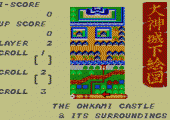
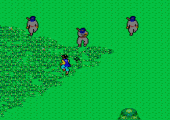
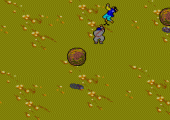
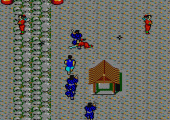
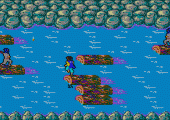
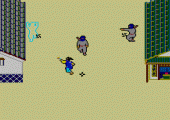
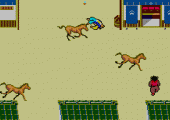
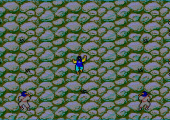
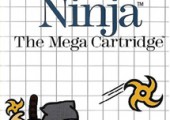
I definitely enjoyed this game. I thought the music was great. It was a good challenge. You are correct, the ending kinda stunk.